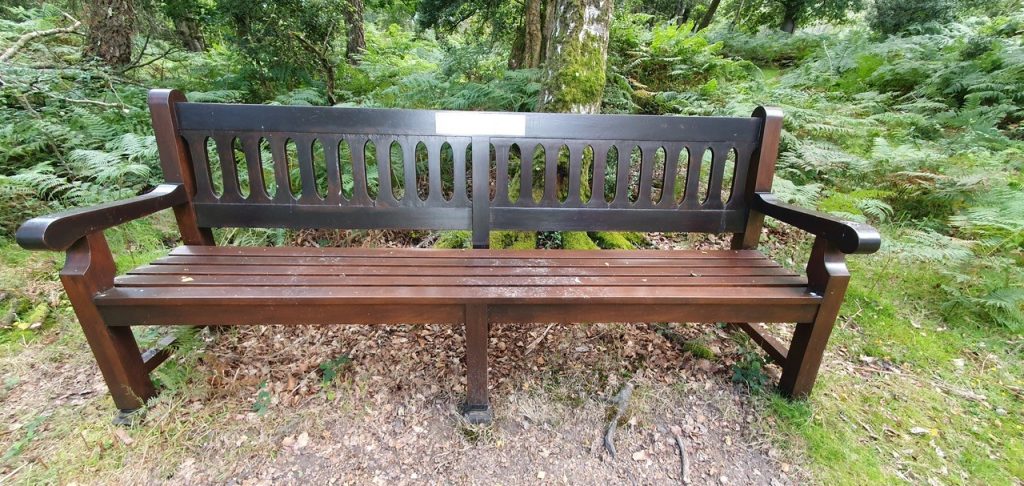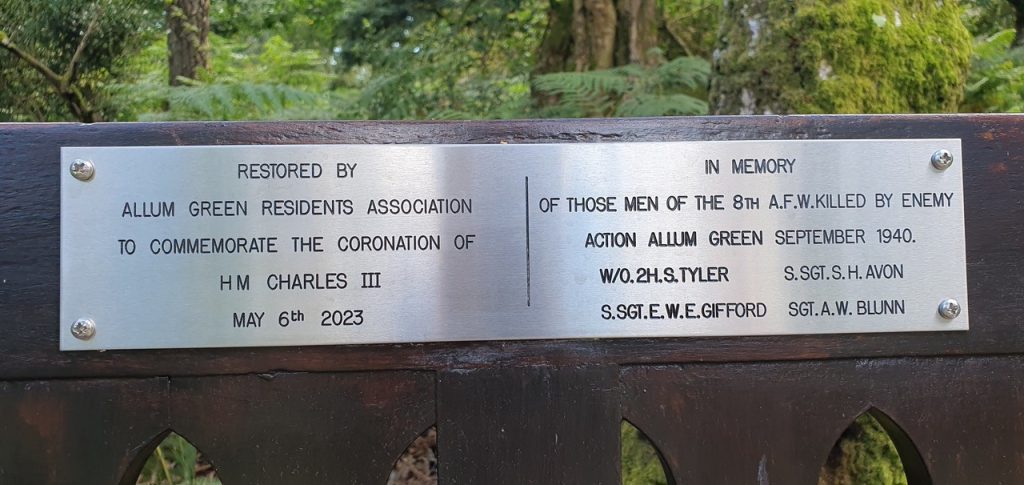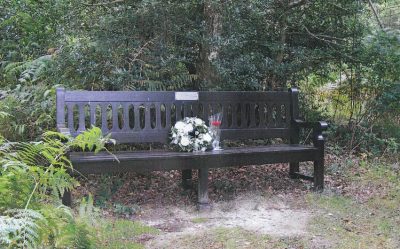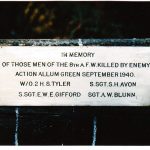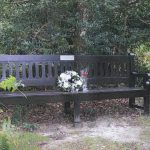Allum Green Memorial Bench
Allum Green, Lyndhurst, Hampshire
This memorial is on a low bank overlooking the house, farm and cottages which make up the hamlet of Allum Green, all previously part of a small estate. It commemorates an air raid during the night of 5th September 1940, when one of several high explosive bombs dropped around the hamlet fell on Allum Green House, passing through the officers’ sleeping quarters in the upper storey and exploding in the Sergeants’ Mess in the cellar. Four men were killed and between 14 and 17 wounded were taken to Lymington Hospital.
The bench is here due to the determined efforts of Sergeant Arthur William James Haynes that his four lost comrades should not be forgotten. He found that the incident was virtually unknown to the inhabitants of Lyndhurst and the Army authorities. After bringing it to their attention, Arthur obtained permission from the Forestry Commission for a memorial to be sited here, with the approval of the local British Legion, the Worcestershire Regiments’ Association and the Dunkirk Veterans’ Association. The bench was purchased with donations from former No. 8 AFW comrades, and was dedicated on 17th May 1980 in the presence of survivors and family members, Army officers and the local British Legion. Since the disbandment of the British Legion branch, it has been cared for by the residents of Allum Green at their own expense, and they have given generously of time and hospitality to the bench’s visitors.
The No. 8 Army Field Workshop, RAOC, comprised of units from Kidderminster, Dudley, Stourbridge and Worcester as part of the Territorial Army, with HQ in Kidderminster. It was formed in 1939 in response to a need for skilled technical personnel, and was mobilised into the regular army on 2nd September, with limited military training and equipment. In order to balance the trades needed in each Section and at HQ, various personnel were transferred and specialists on Army equipment were drafted in from other areas. This probably accounts for the inclusion of Staff Sergeant Gifford from Wiltshire and Staff Sergeant Avon from London, neither of whom had previous connections to Worcestershire or the Territorials.
There followed a period of training and, on 26th January 1940, the whole of No. 8 AFW left Southampton aboard ss Antwerp for Cherbourg, as part of the British Expeditionary Force.
They moved by train to Oisseau-le-Petit, between Alencon and Le Mans, there continuing training and reorganising personnel. Between 3rd and 5th March they moved to Namps-au-Val, near Amiens, to establish workshops and take in recovery and repair work.
On 18th March No. 2 Section was despatched to Beaumetz and No. 3 to Courcelette, and on 13th May they both joined No. 1 Section which had already moved to Roubaix, east of Lille, where 2 Corps had its HQ. Both Sections were working on vehicles brought in from other formations. After a short foray into Belgium, the whole Unit was ordered back to Neuve Chapelle on 20th May, due to the German advance. Orders were received on 23rd May to proceed to Dunkirk, via Bissezeele and Bergues, where a few men were left on tank repair duty. Billets were found in the Dunkirk suburb of Rosendael, but many men were accommodated in freshly dug trenches. A small party was evacuated to England on 26th May. There were constant air raids, and in the confusion some of the men became separated from their comrades and had to find their own way back to England as best they could. The ship originally planned for the Unit’s evacuation from Dunkirk, the ss Worthtown, was bombed in Dunkirk harbour and partially sunk; it is not known which vessel eventually transported them home to Dover.
On arrival, the majority of the three Sections were sent to the Aldershot area, given 48 hours’ leave and then spent about six weeks billeted at various locations around Burley, including Woods Green and Burley Village Hall. Reassembled into their correct groups, they were then despatched to Testwood School, Totton for a short time; No. 2 Section was eventually sent to Allum Green House and used the Imperial Garage in Lyndhurst (now Meridien Modena, a Ferrari dealer) as a workshop. No. 1 Section moved to Petersfield and No. 3 Section to Bishops Waltham. After the air raid on 5th September, the survivors returned briefly to Totton; soon afterwards the Army reorganised their resources so that recovery and repair sections were reallocated to Divisions rather than Corps. As No. 8 AFW no longer existed, its former members came under the authority of the 4th Infantry Division, later seeing action in North Africa and Italy.
STANLEY HENRY AVON
Staff Sergeant
7607811
No. 2 Recovery Section, No. 8 Army Field Workshop, RAOC
died on 5th September 1940, aged 31
Stanley Henry Avon was born on 5th March 1909 to Henry and Nellie Avon (nee Chitty) of East Greenwich, south-east London, the third child of five, three of whom died in infancy, and was survived by his sister Doris.
When Henry died in 1921, the family faced very hard times; to make ends meet Nellie repaired neighbours’ boots and Stan (aged 12) used a small knitting machine to make socks for sale. In 1924 Stan was apprenticed as a fitter at Deptford East Generating Station, then worked at the Charlton engineering firm of Graftons Ltd, later moving to Custance & Thompson of Lee Green. His best friend there was Sydney Smith, son of the owner, and later the two of them married the Derham twins.
He had always wanted to be a doctor but it wasn’t possible with the family circumstances as they were, so he joined the St John Ambulance Brigade in 1928 and remained an ambulance officer until his death. When he enlisted for 12 years in the Regular Army on 11 September 1939, he hoped this experience would fit him for the Medical Corps, but the Army wanted a mechanical man rather than a medical man so he was assigned to the RAOC.
Stan married Margaret Isobel Derham (Mollie) on a snowy Christmas Eve in 1938 at St George’s Church, Westcombe Hill, setting up home in Bennett Park, Blackheath. Their only child, Jill, was born in July 1940, seven weeks after Stan’s return from Dunkirk and seven weeks before his death. With family, friends and Army comrades and officers present, he was buried on 9th September in grave no. 395 Q Section at Charlton, his family cemetery, where his mother joined him in 1963.
It was not until 2008 that Jill discovered the exact location of her father’s death, which her mother had never known, and was very moved and grateful to find a memorial to her father and his comrades. Since then she has visited the memorial a few times, notably in 2010 on the 70th anniversary of the air raid in the company of Alan Haynes, son of Sgt Arthur Haynes, the driving force behind the installation of the bench, and Wilf Briggs of No. 3 Recovery Section who knew SQMS Tyler from their time together in No. 3 Section before the latter transferred to No. 2 Section.
HARRY STANLEY TYLER
WOII (SQMS)
7602112
No. 2 Recovery Section, No. 8 Army Field Workshop, RAOC
died on 5th September 1940, aged 42
Harry Stanley Tyler was born in Martley, Worcester, in the summer of 1898, the only son of Harry and Annie Tyler (nee Hebden); he had two sisters, Mary and Nellie. His father was the landlord of the Whitehall Inn, Martley, but later became motor mail contractor at the Royal Mail Garage, Worcester.
Stan served in the Transport Corps in the First World War, and afterwards worked at the garage, which he took over when his father died in 1938.
In 1920 he married Florence Maud Staples in Leominster and they had three sons, Harry, Gordon, and Bryan. They later lived at Tolladine, Worcester.
Stan had joined the Civil Air Guard in 1939 and was then called up into the RAOC, where he became a valuable asset due, not only to his mechanical abilities, but also his skill as a marksman, learned during his time at Worcester Rifle Club.
He was buried in grave no. 4927 in Worcester (Astwood) Cemetery in the presence of family, friends, Army officers and comrades and representatives of Worcester Rifle Club.
ALFRED WILLIAM BLUNN
Sergeant
7603109
No. 2 Recovery Section, No. 8 Army Field Workshop, RAOC
died on 5th September 1940, aged 28
Alfred William Blunn was born in Rednal, Bromsgrove, in the summer of 1912. His parents were Harold Nathan and Madeline Blunn (nee Wilkes); he had two brothers, Arthur and Harold, and two sisters, Madeline and Kathleen Lucy.
He attended Alcester Grammar School and Bromsgrove County High School, and until the war he worked in the service department of Austin Motor Works at Longbridge. In January 1940 he married Margaret Florence Barlow of Selly Oak at Lickey Church.
Alf was a keen sportsman, playing for a number of local football teams and was a valued all-rounder at Barnt Green Cricket Club. Indeed, when he was interred in the family grave (no. 702) in Lickey (Holy Trinity) Churchyard Extension, his cricket bat was buried with him. The war memorial in the churchyard also includes his name.
EDGAR WILLIAM ERNEST GIFFORD
Staff Sergeant
7607804
No. 2 Recovery Section, No. 8 Army Field Workshop, RAOC
died between 5th and 6th September, 1940, aged 30
Edgar William Ernest Gifford was born in Frome, Somerset, in 1910 where his father John Ernest Gifford was a miller and corn merchant. His mother was Bertha Marion, nee Cole,
and he had a brother Philip Ronald and three sisters, Edna Marion, Luena Isabel and Bertha Muriel.
“Giff” attended Frome School and in 1936 he married Kathleen Nash in Trowbridge; they had moved to nearby North Bradley a few months before his death with their two-year-old son John.
Family, friends and army representatives attended the funeral, with an escort from Trowbridge Barracks led by Staff Sergeant Relf, a friend from No. 2 Section, when he was buried in the north west corner of St. Nicholas’ Church, North Bradley.
New Memorial Bench 2023
In 2023 the residents of Allum Green paid to have a new bench erected at the same site.
